![Nelson Stevens, Centennial Vision, Tuskegee University Administration Building, AL, 1980 [destroyed].jpg.gif Nelson Stevens, Centennial Vision, Tuskegee University Administration Building, AL, 1980 [destroyed].jpg.gif](https://486312.frmmmguz.asia/files/square_thumbnails/1a0ef8af8ec25559e5c2c7c66502ba40.jpg)
Centennial Vision
In 1980, on the anniversary of the founding of the Tuskegee Institute, AfriCOBRA member Nelson Stevens created a mural to celebrate the occasion. Although Stevens was commonly an exterior mural painter, he created this mural on the inside of the Tuskegee University Administration Building. The mural contains the images of black history figures such as Booker T. Washington (former president of Tuskegee University), General Chappie James and the Tuskegee airmen of World War II, Cinque, Malcolm X, Martin Luther King Jr., and George Washington Carver, as well as the antislavery figures Harriet Tubman, Sojourner Truth and Frederick Douglass. Also included in the image is a phrase made famous by the African scholar John S. Mbiti, “I Am Because We Are.” This mural no longer exists.
![Marianne DiNapoli-Mylet, Looking Back, A History of the Black Press, 617 Liberty Street [Chronicle building], Winston-Salem, NC, 1998.jpg Marianne DiNapoli-Mylet, Looking Back, A History of the Black Press, 617 Liberty Street [Chronicle building], Winston-Salem, NC, 1998.jpg](https://486312.frmmmguz.asia/files/square_thumbnails/e0cc2766c734172616139639b01f1af0.jpg)
Looking Back, A History of the Black Press
In 1998, Ernie Pitt, the editor of the Winston-Salem Chronicle, requested a mural that depicted the black press in the United States. Responding to his request, muralist Marianna DiNapoli-Mylet, created Looking Back, A History of the Black Press on the Winston-Salem Chronicle building, In the mural, she shows the history of the black press from 1700 through to the 1960s. The mural features Frederick Douglass most prominently in the centre, with other individuals including W.E.B. Du Bois on the periphery.
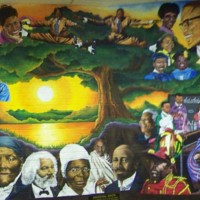
Ancestral Roots
Pontella Mason is one of Baltimore’s unsung visual artists. He has created murals for the Anacostia Community Museum, former President Jimmy Carter, and several other public organisations. His murals depict African American life and the diaspora. In 1999, he created the extensive mural Ancestral Roots, which depicts the antislavery heroes Harriet Tubman, Sojourner Truth, and Frederick Douglass, as well as Martin Luther King Jr., Malcolm X, Muhammad Ali, Notorious B.I.G., Tupac, Shirley Chisholm, and Marcus Garvey.
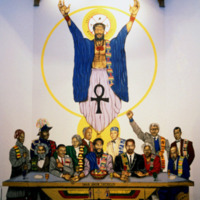
Last Supper
In 1990, muralist Maurice Myron Jenkins created an alternative version of Leonardo da Vinci’s 1494 fresco The Last Supper. The 30 by 19 foot mural depicts the last supper with a black Christ and 12 historical black figures as the prophets. Jenkins chose the Union Temple Baptist Church in Anacostia, Washington D.C. as his canvas because of its role in black history all the way back to its affiliation with Anacostia-resident Frederick Douglass in the 19th century.The mural includes the antislavery figures of Sojourner Truth and Frederick Douglass, as well as Marcus Garvey, Martin Luther King Jr., Rosa Parks, Elijah Muhammad, Malcolm X, Mary McLeod Bethune, Nelson Mandela, Booker T. Washington and W.E.B. Du Bois.
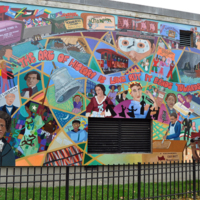
The Arc of History is Long
The muralist David Fichter adapted Martin Luther King Jr.’s famous quotation “the arc of the moral universe is long but it bends towards freedom,” for this 2002 mural in Cambridge, Massachusetts. The mural features Susan B. Anthony, Rosie the Riveter, William Lloyd Garrison and W.E.B. Du Bois, as well as a young Frederick Douglass.At around the same age as he appears in this mural, Douglass gave a speech in nearby Boston on February 8, 1855 where he drew attention to the psychological impact of enslavement: “Whipping is not what constitutes the cruelty of Slavery," explained Douglass. “To me the thought that I am a slave is more terrible than any lash, than any chain.”
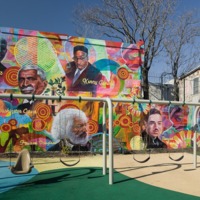
The Faces That Shape Us
On May 25, 2011, a mural titled The Faces That Shape Us, was dedicated in Uncle David’s Playground. Mr Kenneth Gamble (pictured on the mural), the founder and chairman of Universal Companies, had bought a rundown building in South Philadelphia and tore it down. He wanted to bring something positive to the neighbourhood and so he funded a local children’s playground, complete with a mural. Muralists Keir Johnston and Ernel Martinez started the mural in the summer of 2010. The mural features Frederick Douglass and other historical figures such as W.E.B. Du Bois, George Washington Carver and James Baldwin, as well as local figures Dr. Emmett Chapell, Judge Frederica Jackson, and Faatimah Gamble. The mural was developed through a partnership with Universal Companies, the Philadelphia Prison System and the City of Philadelphia Department of Human Services.
![Curtis Lewis, African Amalgamation of Ubiquity, 9980 Gratiot Avenue, Detroit, Michigan, 1985 [destroyed in 2013].jpg Curtis Lewis, African Amalgamation of Ubiquity, 9980 Gratiot Avenue, Detroit, Michigan, 1985 [destroyed in 2013].jpg](https://486312.frmmmguz.asia/files/square_thumbnails/3ac63b31ad894031e7c74b99651ace4a.jpg)
African Amalgamation of Ubiquity
In 1985, muralist Curtis Lewis created a mural on the side of a drug rehabilitation centre on Gratiot Avenue, Detroit, Michigan. The building belonged to Operation Get Down and included the antislavery figures Frederick Douglass and Harriet Tubman, as well as Malcolm X, Mary McLeod Bethune, Jesse Jackson, Thurgood Marshall, Martin Luther King Jr., W.E.B. Du Bois, Booker T. Washington, Ida B. Wells, Marcus Garvey and Nelson Mandela, alongisde Egyptian, Nubian and pharaoh figures. The man who breaks free of his chains in the centre of the mural holds a sign that reads, “Behold my people, arise, stand strong and proud, for ye come from pharaohs, emperors, kings and queens.” The mural was destroyed in 2013.
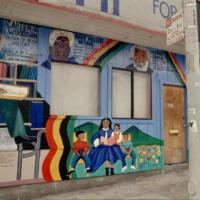
Scenes from the Bayview Opera House
Painted in 1995 in San Francisco by artist Leboriae P. Smoore, this mural acts as a children’s textbook in the street, teaching about the antislavery leaders Harriet Tubman and Frederick Douglass, and other black figures: Carter G. Woodson, Mary McLeod Bethune, W.E.B. Du Bois, Ida B. Wells, and Jackie Robinson.
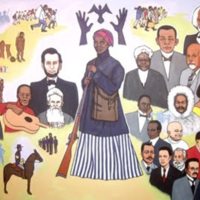
From Africa to America
Wilfred R. Stroud created this seven-panel mural in 1988 to be installed on the first floor of the Tubman Museum. It remains a signature piece in the Museum’s collection today. When the mural was being created, Stroud expained: “The purpose of this mural is to present a visual history of the black man and woman from the earliest times in Africa to the present times in America. The panels focus attention upon the impact of outstanding persons, and events that made a change in the lives and conditions of black people in particular, and the world in general.” Stroud dedicated an entire panel to the topic of slavery. Harriet Tubman stands in the centre, holding a rifle and surrounded by other antislavery leaders: Sojourner Truth, Abraham Lincoln, Frederick Douglass and John Brown.
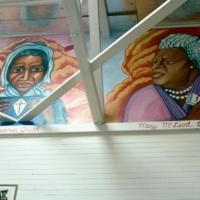
The Great Cloud of Witnesses
In 1992, Selma Brown, Susan Cervantes and Ronnie Goodman painted images of the antislavery leaderes Sojourner Truth, Harriet Tubman and Frederick Douglass, as well as Mary McLeod Bethune, W.E.B. Du Bois, and Thurgood Marshall, at Ingleside Presbyterian Church and Community Center in San Francisco, California. The mural, titled The Great Cloud of Witnesses, was started by Revered G. when he pasted a single newspaper clipping of his hero, Muhammad Ali to the wall of the church gymnasium in 1980. Over the decades, the collage expanded to cover the entire gym, fellowship hall, stairways, hallways, bathrooms, basement and meeting rooms. The mural is multi-faceted and contains newspapers, magazine clippings, photographs, flyers, posters, prints, poetry and painted murals.
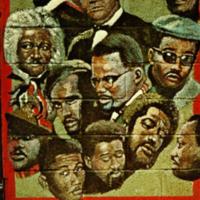
Nation of Islam
In 1990, this mural titled Nation of Islam at Charles Place in Brooklyn was created. The mural unites many radical figures of black history, including the antislavery leader Frederick Douglass, W.E.B. Du Bois, Elijah Muhammad, H. Rap Brown, Malcolm X, Marcus Garvey, Eldridge Cleaver and Bobby Seale. It has now been destroyed.
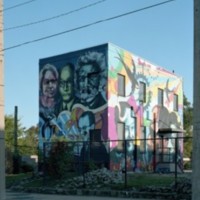
Seven Hills School Mural
Ed Trask, a Richmond-based muralist, created this mural in 2011 at the Seven Hills School in Richmond. It depicts the antislavery leader Frederick Douglass, as well as local figures Maggie Walker, Oliver W. Hill and Spottswood Robinson III. The other side of the building depicts Langston Hughes and W.E.B. Du Bois.
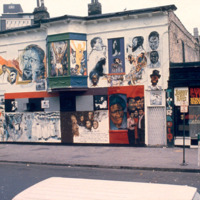
Wall of Respect
The Wall of Respect was the first exterior African American mural in the United States. Painted by OBAC (Organisation of Black American Culture), it underwent three main phases, as shown throughout the photographs here. Its creation was an inclusive process, asking local residents to decide which black heroes should be included in the mural. This was an integral step in the mural-making process because “any muralist who’s doing anything of a thoughtful nature should always have an input from the community,” artist Bill Walker observed. “You can’t do things that make people think they’re not a part of things.” Compiling a newsletter and consulting local militant street gangs, OBAC wrote a list of historic and contemporaneous figures to be memorialised on the wall, before waiting for their approval. “The militant [members of the community] were the ones that defined who would go on the wall and who would not,” artist Eugene Eda Wade remembers in a 2017 oral history interview. The choices were figures from the past and present who “charted their own course” through life and “did not compromise their humanity,” including the antislavery leader Nathaniel Turner, as well as James Brown, James Baldwin, Thelonious Monk, Malcolm X, Nina Simone, Claudia McNeil, Stokely Carmichael, H. Rap Brown, Elijah Muhammad, Gwendolyn Brooks and Muhammad Ali. By celebrating radical black heroes of the past and present, the mural became a site of black cultural heritage and an unofficial landmark on Chicago’s southside. It also catalysed a national mural movement, with more than 300 murals painted in Chicago alone over the next few decades. In 1971, the mural was destroyed in a fire.
![Leroy White, Wall of Respect, Up You Mighty Race, Leffingwell & Franklin Aves, St. Louis MO, 1968 [destroyed 1980s].jpg Leroy White, Wall of Respect, Up You Mighty Race, Leffingwell & Franklin Aves, St. Louis MO, 1968 [destroyed 1980s].jpg](https://486312.frmmmguz.asia/files/square_thumbnails/ccbe25581b885dd6ea7ad25405af90fe.jpg)
Wall of Respect/Up You Mighty Race
In 1968, after the success of Chicago’s Wall of Respect in 1967, muralist Leroy White painted Wall of Respect/Up You Mighty Race in St. Louis, Missouri. The mural was self-sponsored. After seeing Chicago’s Wall of Respect in Ebony, muralists in St. Louis were inspired to create public art in the Carr Square area of the city. The mural was completed by a coalition of individuals from civil rights groups, including CORE, ACTION, and the Zulu 1200s. It displayed a pantheon of black heroes, including the antislavery leaders Frederick Douglass, Malcolm X, Martin Luther King Jr., and Marcus Garvey. The mural quickly became a hub of black activism—bringing together artists, performers and political figures in a series of concerts and rallies at the site. But it was vandalised during the 1970s, and its building was razed in the 1980s.
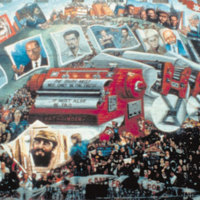
Pathfinder Mural
In 1988, Mike Alewitz designed and began to direct the creation of Pathfinder Mural in New York City’s West Village. The mural, measuring 79 x 85 feet, was an international collaboration of 80 artists from 20 different countries including Argentina, Canada, Iran, New Zealand, Nicaragua and South Africa. At its dedication, it was hailed as one of the largest political murals in the world. In 1987, Alewitz had approached the leaders of the Socialist Workers Party (SWP), of which he was a member, and proposed that Pathfinder Press sponsored a mural for its Charles Street building. The party approved both the project and his concept of the mural: a celebration of the revolutionary struggles in Cuba, Grenada, Nicaragua and South Africa, as well as in America. The central image of the mural is a large red printing press. The faces of Fidel Castro, Che Guevara, Malcolm X, Karl Marx, and Nelson Mandela loop around it. The abolitionists Frederick Douglass, Harriet Tubman and Sojourner Truth also feature. During the creation of Pathfinder Mural, the National Endowment for the Arts withdrew funding from several controversial projects, prompting a debate on free speech and censorship. For the first few months of this mural's creation, work continued without incident. But in 1989, Patrick Buchanan, a conservative commentator, vilified the mural in the Washington Times, calling it a “six-story shrine to communism, a Marxist Mount Rushmore in Greenwich Village." As the mural neared completion, the dialogue between Alewitz and the SWP started to break down. Alewitz was blocked from attending the mural dedication ceremony on November 19, 1989. During December, vandals threw glass bottles filled with white paint at the mural. In 1996, the mural was removed in order to repair cracks in exterior wall of the Pathfinder building, and by 2003, the building on which Pathfinder Mural was housed was sold for around $20 million.
![Don Rodgers, Our Brothers and Sisters, 100th and Halsted Streets [Black Neighborhood], Chicago, 1984.jpg Don Rodgers, Our Brothers and Sisters, 100th and Halsted Streets [Black Neighborhood], Chicago, 1984.jpg](https://486312.frmmmguz.asia/files/square_thumbnails/ade8cb4554aca77fae33825bf55434dc.jpg)
Our Brothers and Sisters
Titled Our Brothers and Sisters, this mural depicts figures of black history, including the abolitionist Frederick Douglass and also Harold Washington, Martin Luther King Jr., Booker T. Washington, Malcolm X, W.E.B. Du Bois, and Louis Armstrong.
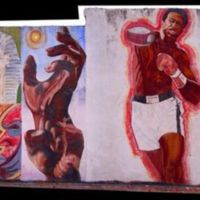
Wall of Respect
Borrowing its name from the 1967 “Wall of Respect” of Chiacgo, muralists Ashanti Johnson, Nathan Hoskins and Verna Parks installed their own public artwork in Atlanta. The abolitionist Frederick Douglass is alongside Martin Luther King Jr., Malcolm X and W.E.B. Du Bois, with the North Star between them. Angela Davis and Muhammad Ali are also present. The mural was destroyed in 2007.